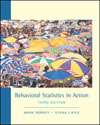Mark W. Vernoy,
Palomar College
Diana J. Kyle,
Fullerton College
| Between-subjects design | is sometimes called an independent-group design. In this design, each level of each independent variable has different participants. Thus, there is a distinction between each level of the experiment because each participant participates only in one level.
|
 |
 |
 |
| Completely randomized experimental design | is a design with at least one independent variable with at least two levels. Participants are both randomly selected to participate in the study and randomly assigned to one of the groups in a completely random fashion.
|
 |
 |
 |
| Completely randomized factorial experimental design | is a completely randomized experimental design, except there are at least two independent variables, each having at least two levels.
|
 |
 |
 |
| Demand characteristics | are changes in participants' behavior or responses based on their knowledge of the research hypothesis. When the research hypothesis is transparent or the participants think they know it, then their behavior may be changed to either support or not support the research hypothesis.
|
 |
 |
 |
| Dependent variables | are measurements of the effect(s) of the independent variable on the behavior being studied in an experiment.
|
 |
 |
 |
| Experimental control | is a scientific technique to help rule out alternative explanations for the experimental findings. Experimenters attempt to ensure that all conditions of the experiment are identical except for the manipulated independent variable.
|
 |
 |
 |
| Experimenter bias | takes place when experimenters, knowing the research hypothesis, unknowingly behave in ways that influence the results of the study in favor of the predicted research hypothesis. The experimenter's behavior may differ in many ways including facial expression, verbal instructions, or body language.
|
 |
 |
 |
| Extraneous variables | may vary in an experiment and affect participants' behavior. An experimenter tries to control extraneous variables. If an extra variable(s) varies between the conditions, then the experimenter cannot be sure whether it was the independent variable or the extra variable that caused any detected differences in participants' behavior between conditions.
|
 |
 |
 |
| Hypothesis | is a specific research prediction concerning the behavior being studied. A scientific hypothesis is a prediction based predominantly on a scientific theory or body of knowledge.
|
 |
 |
 |
| Independent variables | are those variables that are manipulated by the experimenter in order to determine what effect they may have on behavior. The experimenter varies the independent variable(s) from one condition to another in the experiment. By applying this factor(s) to one condition and not another, the experimenter compares the effect of the independent variable on the behavior of interest.
|
 |
 |
 |
| Mixed design | occurs most often when there are at least two independent variables and each person participates in all levels of one variable but not all levels of at least one of the other variables.
|
 |
 |
 |
| Null hypothesis | (Ho) is one of two mutually exclusive hypotheses in a research study. It is a prediction or explanation that there is no difference between sample means. It is the hypothesis that is tested in statistics.
|
 |
 |
 |
| One-group experimental design | is a design in which a single sample mean is compared to the mean of a known population.
|
 |
 |
 |
| One-tailed test | is a test for significance of a hypothesis that specifies the direction of the experimental effect.
|
 |
 |
 |
| Power | is the probability that a statistical test will correctly reject the null hypothesis when the null hypothesis is false. Several factors can affect the power of statistical test, such as the size of alpha, sample size, the difference between the means of two populations that the samples come from, and the type of statistical test used in the analysis.
|
 |
 |
 |
| Research hypothesis | (H1) is one of two mutually exclusive hypotheses in a research study. It is a prediction or explanation that there is a difference between sample means.
|
 |
 |
 |
| Subject variables | are variables that describe the characteristics or attributes of participants in the study that cannot be attributed to the manipulation of the independent variable. Examples of subject variables are gender, age, year in school, marital status, etc.
|
 |
 |
 |
| Two-tailed test | is a test for significance of a hypothesis that does not specify the direction of the experimental effect.
|
 |
 |
 |
| Type I error | is one of two incorrect decisions possible in statistics. This error takes place when researchers reject the null hypothesis and the null hypothesis is actually true.
|
 |
 |
 |
| Type II error | is one of two incorrect decisions possible in statistics. This error takes place when researchers fail to reject the null hypothesis and the null hypothesis is actually false.
|
 |
 |
 |
| Within-subjects design | is also called a repeated-measures design. In this design, each participant participates in all levels of all independent variables. Each participant stays within the experiment for its entire run.
|



 2002 McGraw-Hill Higher Education
2002 McGraw-Hill Higher Education